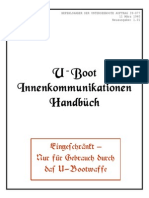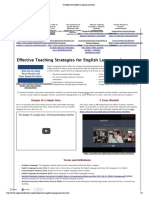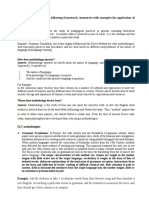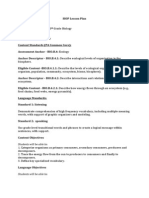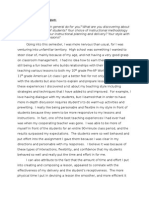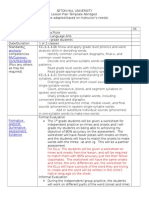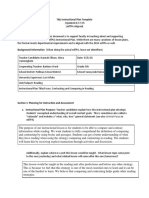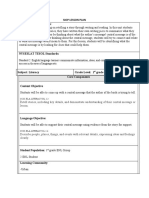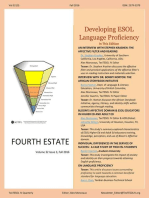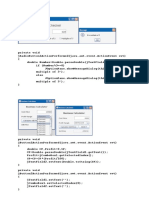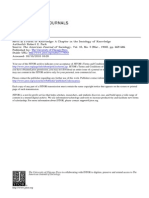Final Lesson
Final Lesson
Uploaded by
api-503945134Original Description:
Original Title
Copyright
Available Formats
Share this document
Did you find this document useful?
Is this content inappropriate?
Copyright:
Available Formats
Final Lesson
Final Lesson
Uploaded by
api-503945134Copyright:
Available Formats
UCLA Extension Clear University Induction Program
LESSON PLANNING GUIDE
Inquiry I: Effective Learning Environments and Supporting Cultural Diversity
This guide may be used for the Culturally Relevant Lesson Plan, as well as the lesson observed by your Support Provider or Mentor Teacher.
Topic of Lesson: ______Assumptions (Implicit Bias)________________________________________ Date: ____06/01/19_________
Inquiry Question: What assumptions do we make about others based on appearances? Grade Level: ____10______
Expected Outcomes: What is your learning objective for students to know Behavioral Needs Focus Student: How will you modify, accommodate,
at the end of this lesson? or differentiate instruction to ensure universal access to curriculum for
your Focus Student?
Students should think deeper about the assumptions they make based
Zach (as per 504 Plan) – Intentionally pair with Zara or Brittany
on appearances.
and make sure they work close to my desk.
Assessment: What evidence of learning will you gather to assess student Flexible Grouping Strategies: How will you group students in the lesson
learning? to address identified language, academic, and instructional needs for
Share during THINK-PAIR-SHARE individual students?
Exit ticket reflecting on why students make the assumptions
ELL students who share native language paired together for
THINK-PAIR-SHARE to help enable L1 use to discuss more in
depth
Pair students whose perspectives may differ
What academic content standard(s) will you focus on during this lesson?
Listening & Speaking Strategies 1.1 – Formulate judgements about the ideas under discussion and support those judgements with convincing
evidence.
Lesson Differentiation: Explain how you will ensure student engagement and differentiate within this lesson to meet the needs of students who have
learning difficulties, students who are language learners, and students who are gifted.
Students are encouraged to free write journal entry in whatever style, lang, etc. they choose
UCLA Extension Clear University Induction Program- Lesson Planning Guide
UCLA Extension Clear University Induction Program
LESSON PLANNING GUIDE
Inquiry I: Effective Learning Environments and Supporting Cultural Diversity
Lesson Design: Explain your planned activities to meet your learning objective.
Pass out magazine clippings of a variety of people – clippings represent people from a variety of cultural and professional backgrounds (ideally
including some famous/accomplished figures that students may not readily recognize). – Two-four copies of each image are distributed.
Ask students to look at the image and IMAGINE who this person is.
JOURNAL – write a description of the person. Who are they? What is their story? What are they like? Job? Lifestyle? Accomplishments? Fears?
PAIR/GROUP – Students find the other student(s) who has the same person/image. DISCUSS – Share your description with your partner? How
did your descriptions compare? Was there anything similar? What was different? Why do you think you had similar or different descriptions?
SHARE – Select some students to briefly share with the class whether their partners had similar descriptions and why they think their descriptions
were similar or different.
SLIDESHOW – Show images then brief description of who the person really is.
HUMAN THERMOMETER – First: students stand up if their imagined description had anything in common with the real person’s story. Then, on
a Scale of “spot on” (front of the room)– “totally different”(back of the room) students rate their description in comparison with the person’s real
story.
THINK-PAIR-SHARE – Return to previous pair/group. THINK - Were you surprised by the real description of your person? Why or why not?
What assumptions did you make based on the persons appearance? Why might your assumptions have been different than the group? Take
questions one at a time and offer opportunity for a few students to SHARE their answers with the class.
?EXPLICIT TEACH – “bias” “explicit bias” “implicit bias”?
EXIT TICKET – What assumptions do make based on appearances? Are these assumptions always fair? What knowledge or experience to you
think you base these assumptions on? (you might use a specific example from this exercise or any others that come to mind)
Academic Vocabulary Instruction: What specific vocabulary/terms will Culturally Relevant: How is this lesson relevant to the students in your
you explicitly teach and have students practice during this lesson to ensure class? How does this lesson encourage a classroom that is supportive of
concept understanding? diversity?
In the past, I have not explicitly taught vocabulary as part of this lesson. Encourages students to imagine the lives of people who may be
This may be an occasion to introduce vocabulary around bias, though. different from them
Perhaps, “bias” “implicit bias” and “explicit bias”? Challenges students to examine and challenge the assumptions they
make about others
Exposes students to thought leaders and role models from a variety
of cultural backgrounds
UCLA Extension Clear University Induction Program- Lesson Planning Guide
UCLA Extension Clear University Induction Program
LESSON PLANNING GUIDE
Inquiry I: Effective Learning Environments and Supporting Cultural Diversity
Classroom Management: What do you anticipate your focus student will Integration of Technology: How will you integrate available technology
need to be successful with this lesson? What other issues should you resources into this lesson as you plan, teach, and assess student learning?
consider to ensure a safe and inclusive environment for student learning? How might students use technology in this lesson to deepen their
understanding of the content?
Projector or smartboard to project images – students gain broader
Fronting discussion about why the descriptions might not have
perspective beyond the person/image they looked at in detail.
matched with reminder about using careful/considerate language
when discussing with classmates? Depending on available technology, students might look up or do an
interactive share of definitions of explicitly taught vocabulary.
Acknowledging that implicit bias (which many students may admit or
be “outed” in displaying) is not the same as overt racism, but can
have hurtful consequences
UCLA Extension Clear University Induction Program- Lesson Planning Guide
You might also like
- EX403 Study NotesDocument7 pagesEX403 Study Notesr.b. senthil babu r.b. senthil babuNoch keine Bewertungen
- Ucla 426Document5 pagesUcla 426api-241800671Noch keine Bewertungen
- Siop Lesson Plan-CnyDocument3 pagesSiop Lesson Plan-Cnyapi-262899083Noch keine Bewertungen
- Siop Lesson 1Document3 pagesSiop Lesson 1api-314913645Noch keine Bewertungen
- Madeline Hunter Lesson Plan ParagraphsDocument3 pagesMadeline Hunter Lesson Plan Paragraphsapi-352928743100% (1)
- Tled 435 Livetext Ss LP TemplateDocument12 pagesTled 435 Livetext Ss LP Templateapi-375469242Noch keine Bewertungen
- SIOP Instructional Unit Plan Thematic Topic: Inventors Grade/Class/Subject: 5 StandardsDocument6 pagesSIOP Instructional Unit Plan Thematic Topic: Inventors Grade/Class/Subject: 5 Standardsmglanzman15100% (1)
- Siop 99 Ideas ActivitiesDocument9 pagesSiop 99 Ideas Activitiesapi-305101515Noch keine Bewertungen
- SH3 Innenkommunikatzionen Handbuch V101Document19 pagesSH3 Innenkommunikatzionen Handbuch V101Charlie MooreNoch keine Bewertungen
- Created By: Danica Fe C. GarciaDocument10 pagesCreated By: Danica Fe C. GarciamddddddNoch keine Bewertungen
- Strategies For EllDocument4 pagesStrategies For Ellapi-332850675Noch keine Bewertungen
- Vocabulary Lesson Plan - Hungry CaterpillarDocument3 pagesVocabulary Lesson Plan - Hungry Caterpillarapi-311458903Noch keine Bewertungen
- Grammar, Spelling, Vocab, LessonDocument7 pagesGrammar, Spelling, Vocab, LessonShantae MartinezNoch keine Bewertungen
- Siop Lesson PlanDocument6 pagesSiop Lesson Planapi-475024988Noch keine Bewertungen
- C) Research Study Q3. With Reference To The Following Framework, Enumerate With Examples The Application of MethodologiesDocument6 pagesC) Research Study Q3. With Reference To The Following Framework, Enumerate With Examples The Application of MethodologiesNidhi MathurNoch keine Bewertungen
- Siop English Lesson PlanDocument5 pagesSiop English Lesson Planapi-321584757Noch keine Bewertungen
- Student Teaching Experience ReflectionDocument2 pagesStudent Teaching Experience Reflectionapi-302381669Noch keine Bewertungen
- Mintzer Final Siop ActivitiesDocument5 pagesMintzer Final Siop Activitiesapi-251583101Noch keine Bewertungen
- Third Grade Comprehensive Unit Plan Andrew Langhorne Stephanie Shipp Meghan Tomasi Sarah Wolfe James Madison UniversityDocument17 pagesThird Grade Comprehensive Unit Plan Andrew Langhorne Stephanie Shipp Meghan Tomasi Sarah Wolfe James Madison Universityapi-334275716Noch keine Bewertungen
- Antonyms Unit PlanDocument22 pagesAntonyms Unit Planapi-456730383Noch keine Bewertungen
- Reading Writing ELLDocument11 pagesReading Writing ELLjaceyNoch keine Bewertungen
- Learning To Add: Kindergarten MathDocument15 pagesLearning To Add: Kindergarten MathJorge Gamarra Tolentino100% (1)
- Updated Final Lesson Plan 1-4-12-2015Document10 pagesUpdated Final Lesson Plan 1-4-12-2015api-285562399Noch keine Bewertungen
- SIOP Lesson PlanDocument4 pagesSIOP Lesson PlanPayton BallNoch keine Bewertungen
- Technology Lesson PlanDocument8 pagesTechnology Lesson Planapi-510156982Noch keine Bewertungen
- Feedback To Students: Rosalind Duhs Centre For The Advancement of Learning and Teaching (CALT)Document29 pagesFeedback To Students: Rosalind Duhs Centre For The Advancement of Learning and Teaching (CALT)Ohio2013Noch keine Bewertungen
- English Language Curriculum FISTADocument43 pagesEnglish Language Curriculum FISTABobi BallaNoch keine Bewertungen
- Texas Wesleyan University Lesson Plan: Domain-DimensionsDocument4 pagesTexas Wesleyan University Lesson Plan: Domain-Dimensionsapi-340630807Noch keine Bewertungen
- Tws Reflection and CritiqueDocument5 pagesTws Reflection and Critiqueapi-265180782Noch keine Bewertungen
- Memo Lssonplans Meth 5Document4 pagesMemo Lssonplans Meth 5api-3070165030% (1)
- Unit LessonDocument7 pagesUnit Lessonapi-272866709Noch keine Bewertungen
- Small Group Lesson Plan FishingDocument4 pagesSmall Group Lesson Plan Fishingapi-594519491Noch keine Bewertungen
- F 9 D 718847 DCB 90 A 2 B 321Document6 pagesF 9 D 718847 DCB 90 A 2 B 321api-661468703Noch keine Bewertungen
- Kelceys Ell Lesson PlanDocument7 pagesKelceys Ell Lesson Planapi-300746636Noch keine Bewertungen
- Advocacy GDocument7 pagesAdvocacy Gapi-530384801Noch keine Bewertungen
- Individual Learning Plan - BenDocument4 pagesIndividual Learning Plan - Benapi-317390418Noch keine Bewertungen
- 8 Lesson 2 - Peer TeachingDocument5 pages8 Lesson 2 - Peer Teachingapi-384800531Noch keine Bewertungen
- Mystery Bag 5 WH Writing Lesson PlanDocument4 pagesMystery Bag 5 WH Writing Lesson Planapi-236986052Noch keine Bewertungen
- Summary - Writing and Language Socialization Across CulturesDocument2 pagesSummary - Writing and Language Socialization Across Culturesapi-563411264Noch keine Bewertungen
- Eld Lesson PlanDocument4 pagesEld Lesson Planapi-307224989Noch keine Bewertungen
- Observation Task 3Document2 pagesObservation Task 3api-307983330Noch keine Bewertungen
- Pre-Planning: CC.1.1.1.D: Know and Apply Grade Level Phonics and WordDocument7 pagesPre-Planning: CC.1.1.1.D: Know and Apply Grade Level Phonics and Wordapi-280008473Noch keine Bewertungen
- Fall 2018 Ela Edtpa Lesson Plan 1Document5 pagesFall 2018 Ela Edtpa Lesson Plan 1api-327064630Noch keine Bewertungen
- Briley Shinlever Lessonplan Educ216Document5 pagesBriley Shinlever Lessonplan Educ216api-287789432Noch keine Bewertungen
- Educating All Students:: Focus On English Language LearnersDocument74 pagesEducating All Students:: Focus On English Language LearnersJennNoch keine Bewertungen
- Phonics Lesson Plan Baseball - 1Document2 pagesPhonics Lesson Plan Baseball - 1api-308973450Noch keine Bewertungen
- Curriculum Book FinalDocument62 pagesCurriculum Book FinalAnonymous YRCL8ceSNoch keine Bewertungen
- Reading Lesson Plan Hannah and Alexa 1Document12 pagesReading Lesson Plan Hannah and Alexa 1api-434245139Noch keine Bewertungen
- Lessonplantemplate-Iste CordyDocument5 pagesLessonplantemplate-Iste Cordyapi-253462692Noch keine Bewertungen
- 613 Course SyllabusDocument8 pages613 Course SyllabusStanley L. SwartzNoch keine Bewertungen
- Special Education Philosophy StatementDocument2 pagesSpecial Education Philosophy Statementapi-293900058Noch keine Bewertungen
- Udl Lesson Plan TemplateDocument2 pagesUdl Lesson Plan Templateapi-271059388Noch keine Bewertungen
- Siop Lesson Plan - ElementaryDocument8 pagesSiop Lesson Plan - Elementaryapi-547615210Noch keine Bewertungen
- Siop Lesson Plan Wida Level 3Document6 pagesSiop Lesson Plan Wida Level 3api-248121250Noch keine Bewertungen
- Lesson Plan TemplateDocument3 pagesLesson Plan Templateapi-316752530Noch keine Bewertungen
- PLC Powerpoint Eld307 2Document30 pagesPLC Powerpoint Eld307 2api-242063183Noch keine Bewertungen
- Educ 504 Calla Lesson Plan 2Document3 pagesEduc 504 Calla Lesson Plan 2api-241058437Noch keine Bewertungen
- Applying Indirect Strategies To The Four Language SkillsDocument6 pagesApplying Indirect Strategies To The Four Language SkillsWahyu AsikinNoch keine Bewertungen
- Working Lesson PlanDocument5 pagesWorking Lesson Planapi-623457578Noch keine Bewertungen
- Spede 774 Writing Lesson PlanDocument4 pagesSpede 774 Writing Lesson Planapi-273589202Noch keine Bewertungen
- Fostering International Student Success in Higher Education, Second Edition: copublished by TESOL and NAFSAFrom EverandFostering International Student Success in Higher Education, Second Edition: copublished by TESOL and NAFSANoch keine Bewertungen
- Preston Lee's Conversation English For Japanese Speakers Lesson 21: 40From EverandPreston Lee's Conversation English For Japanese Speakers Lesson 21: 40Noch keine Bewertungen
- Always Remember Us This WayDocument3 pagesAlways Remember Us This WaySUSANA ZARATENoch keine Bewertungen
- Nonlinear Equations and Systems of Equations (Level 3) Answer KeyDocument25 pagesNonlinear Equations and Systems of Equations (Level 3) Answer Keyansh09febNoch keine Bewertungen
- Development of A Cost-Effective IoT-Based Weather Monitoring SystemDocument6 pagesDevelopment of A Cost-Effective IoT-Based Weather Monitoring SystemNana SutisnaNoch keine Bewertungen
- GR 5 Lesson 2 - PrefixesDocument37 pagesGR 5 Lesson 2 - PrefixesJaeza Mae NapizaNoch keine Bewertungen
- Music History Study GuideDocument21 pagesMusic History Study GuidejeremystrongNoch keine Bewertungen
- Basic Grammar 4Document7 pagesBasic Grammar 4Jeliza EscalañaNoch keine Bewertungen
- SIMATIC-Replace S5-S7-1500 (v1.0)Document110 pagesSIMATIC-Replace S5-S7-1500 (v1.0)Jorge_Andril_5370Noch keine Bewertungen
- Lab PracticeDocument11 pagesLab PracticeAdarsh Bhatnagar100% (1)
- Thavasi BeDocument3 pagesThavasi BeNijanthan PnijanthanNoch keine Bewertungen
- Present Simple: Yes/No Questions Questions UseDocument67 pagesPresent Simple: Yes/No Questions Questions UseFranco RanalliNoch keine Bewertungen
- Star Shape Lesson Plan Level 6 Amna AlaaDocument3 pagesStar Shape Lesson Plan Level 6 Amna Alaaapi-309215817Noch keine Bewertungen
- Robert E Park - News As A Form of KnowledgeDocument19 pagesRobert E Park - News As A Form of KnowledgeMichel MisseNoch keine Bewertungen
- 18306apni KakshaDocument30 pages18306apni KakshaVaibhav2006Noch keine Bewertungen
- Filsafat, Ilmu Dan AgamaDocument36 pagesFilsafat, Ilmu Dan AgamaIwan SokaNoch keine Bewertungen
- SPAM Email Detection Methods (By Amran)Document10 pagesSPAM Email Detection Methods (By Amran)Amran IsmailNoch keine Bewertungen
- How To Teach Composition Writing To Children0Document15 pagesHow To Teach Composition Writing To Children0Mjlen B. Reyes100% (2)
- Programs With Outputs - Cycle 1Document9 pagesPrograms With Outputs - Cycle 1Akhil Chowdary MaddineniNoch keine Bewertungen
- Book Review of Love Story Written by Erich SegalDocument10 pagesBook Review of Love Story Written by Erich SegalKidoltiNoch keine Bewertungen
- Activity Book 2Document67 pagesActivity Book 2Blanca GonzalezNoch keine Bewertungen
- BetterBusBuffers UsersGuideDocument17 pagesBetterBusBuffers UsersGuideUsamaNoch keine Bewertungen
- 3RD Term J1 Mathematics-1Document46 pages3RD Term J1 Mathematics-1Olaoye Olumide HabeebNoch keine Bewertungen
- Mock Test 1Document3 pagesMock Test 1Quỳnh TrangNoch keine Bewertungen
- ARTS 9 CURR MAP-1st GradingDocument3 pagesARTS 9 CURR MAP-1st GradingJackNoch keine Bewertungen
- Glossary FundamentalAbhidhammaDocument23 pagesGlossary FundamentalAbhidhammaJaywant DeshpandeNoch keine Bewertungen
- RCR600 User Manual r2Document13 pagesRCR600 User Manual r2John EarleyNoch keine Bewertungen
- Assignment 6 Part 3 (Homework)Document3 pagesAssignment 6 Part 3 (Homework)serachguruNoch keine Bewertungen
- Qing - English Language Contemporary Media Example Bank TemplateDocument20 pagesQing - English Language Contemporary Media Example Bank Templategotengohan73Noch keine Bewertungen








